Development of an Epitaxial Growth Technique Using III-V on a Si Platform for Heterogeneous Integration of Membrane Photonic Devices on Si
Abstract
:Featured Application
Abstract
1. Introduction
2. Epitaxial Growth on InP-on-Insulator Substrate
2.1. Integration Method of III-V Photonic Devices on Si
2.2. Assessment of Thermal Strain at Epitaxial Growth Temperature
2.3. Regrowth of InP
2.4. Growth of Multi-Quantum-Well Double-Hetero Structure
3. Membrane Photonic Devices on Si Substrate
3.1. InGaAlAs Membrane Laser Array Grown on InP-on-Insulator Substrate
3.2. Multi-Bandgap Photonic Devices Using Advanced Epitaxial Growth Technique
3.2.1. Multi-Wavelength Laser Array Using Selective-Area Epitaxial Growth
3.2.2. DFB Laser Integrated with MZM Using Epitaxial Regrowth of InGaAsP
4. Conclusions
Author Contributions
Funding
Institutional Review Board Statement
Informed Consent Statement
Data Availability Statement
Acknowledgments
Conflicts of Interest
References
- Chen, X.; Li, C.; Tsang, H.K. Device engineering for silicon photonics. NPG Asia Mater. 2011, 3, 34–40. [Google Scholar] [CrossRef] [Green Version]
- Rickman, A. The commercialization of silicon photonics. Nat. Photonics 2014, 8, 579–582. [Google Scholar] [CrossRef]
- Nagarajan, R.; Joyner, C.H.; Schneider, R.P.; Bostak, J.S.; Butrie, T.; Dentai, A.G.; Dominic, V.G.; Evans, P.W.; Kato, M.; Kauffman, M.; et al. Large-scale photonic integrated circuits. IEEE J. Sel. Top. Quantum Electron. 2005, 11, 50–65. [Google Scholar] [CrossRef]
- Komljenovic, T.; Davenport, M.; Hulme, J.; Liu, A.Y.; Santis, C.T.; Spott, A.; Srinivasan, S.; Stanton, E.J.; Zhang, C.; Bowers, J.E. Heterogeneous Silicon Photonic Integrated Circuits. J. Light. Technol. 2016, 34, 20–35. [Google Scholar] [CrossRef]
- Dong, P.; Liu, X.; Chandrasekhar, S.; Buhl, L.L.; Aroca, R.; Chen, Y.-K. Monolithic Silicon Photonic Integrated Circuits for Compact 100+Gb/s Coherent Optical Receivers and Transmitters. IEEE J. Sel. Top. Quantum Electron. 2014, 20, 150–157. [Google Scholar] [CrossRef]
- Horikawa, T.; Shimura, D.; Okayama, H.; Jeong, S.-H.; Takahashi, H.; Ushida, J.; Sobu, Y.; Shiina, A.; Tokushima, M.; Kinoshita, K.; et al. A 300-mm Silicon Photonics Platform for Large-Scale Device Integration. IEEE J. Sel. Top. Quantum Electron. 2018, 24, 1–15. [Google Scholar] [CrossRef]
- Tsuchizawa, T.; Yamada, K.; Fukuda, H.; Watanabe, T.; Takahashi, J.; Takahashi, M.; Shoji, T.; Tamechika, E.; Itabashi, S.; Morita, H. Microphotonics devices based on silicon microfabrication technology. IEEE J. Sel. Top. Quantum Electron. 2005, 11, 232–240. [Google Scholar] [CrossRef]
- Arakawa, Y.; Nakamura, T.; Urino, Y.; Fujita, T. Silicon photonics for next generation system integration platform. IEEE Commun. Mag. 2013, 51, 72–77. [Google Scholar] [CrossRef]
- Thomson, D.; Zilkie, A.; Bowers, J.E.; Komljenovic, T.; Reed, G.T.; Vivien, L.; Marris-Morini, D.; Cassan, E.; Virot, L.; Fédéli, J.M.; et al. Roadmap on silicon photonics. J. Opt. 2016, 18, 1–20. [Google Scholar] [CrossRef]
- Miller, D. Device Requirements for Optical Interconnects to Silicon Chips. Proc. IEEE 2009, 97, 1166–1185. [Google Scholar] [CrossRef] [Green Version]
- Kobayashi, W.; Ito, T.; Yamanaka, T.; Fujisawa, T.; Shibata, Y.; Kurosaki, T.; Kohtoku, M.; Tadokoro, T.; Sanjoh, H. 50-Gb/s Direct Modulation of a 1.3-μm InGaAlAs-Based DFB Laser With a Ridge Waveguide Structure. IEEE J. Sel. Top. Quantum Electron. 2013, 19, 1500908. [Google Scholar] [CrossRef]
- Nakahara, K.; Wakayama, Y.; Kitatani, T.; Taniguchi, T.; Fukamachi, T.; Sakuma, Y.; Tanaka, S. Direct Modulation at 56 and 50 Gb/s of 1.3-μm InGaAlAs Ridge-Shaped-BH DFB Lasers. IEEE Photonics Technol. Lett. 2015, 27, 534–536. [Google Scholar] [CrossRef]
- Nakahara, K.; Tsuchiya, T.; Kitatani, T.; Shinoda, K.; Taniguchi, T.; Fujisaki, S.; Kikawa, T.; Nomoto, E.; Hamano, F.; Sawada, M.; et al. 1.3-μm InGaAlAs directly modulated MQW RWG DFB lasers operating over 10 Gb/s and 100 °C. In Proceedings of the Optical Fiber Communication Conference (OFC), Los Angeles, CA, USA, 22 February 2004; Available online: https://www.osapublishing.org/abstract.cfm?URI=OFC-2004-ThD1 (accessed on 18 January 2021).
- Fujisawa, T.; Kanazawa, S.; Takahata, K.; Kobayashi, W.; Tadokoro, T.; Ishii, H.; Kano, F. 1.3-μm, 4 × 25-Gbit/s, EADFB laser array module with large-output-power and low-driving-voltage for energy-efficient 100GbE transmitter. Opt. Express 2012, 20, 614. [Google Scholar] [CrossRef] [PubMed]
- Takeuchi, H.; Tsuzuki, K.; Sato, K.; Yamamoto, M.; Itaya, Y.; Sano, A.; Yoneyama, M.; Otsuji, T. Very high-speed light-source module up to 40 Gb/s containing an MQW electroabsorption modulator integrated with a DFB laser. IEEE J. Sel. Top. Quantum Electron. 1997, 3, 336–343. [Google Scholar] [CrossRef]
- Kawamura, Y.; Wakita, K.; Yoshikuni, Y.; Itaya, Y.; Asahi, H. Monolithic Integration of a DFB Laser and an MQW Optical Modulator in the 1.5 µm Wavelength Range. IEEE J. Quantum Electron. 1987, 23, 915–918. [Google Scholar] [CrossRef]
- Griffin, R.A.; Jones, S.K.; Whitbread, N.; Heck, S.C.; Langley, L.N. InP Mach–Zehnder Modulator Platform for 10/40/100/200-Gb/s Operation. IEEE J. Sel. Top. Quantum Electron. 2013, 19, 158–166. [Google Scholar] [CrossRef]
- Ogiso, Y.; Ozaki, J.; Kashio, N.; Kikuchi, N.; Tanobe, H.; Ohiso, Y.; Kohtoku, M. 100 Gb/s and 2 V Vπ InP Mach-Zehnder modulator with an n-i-p-n heterostructure. Electron. Lett. 2016, 52, 1866–1867. [Google Scholar] [CrossRef]
- Justice, J.; Bower, C.; Meitl, M.; Mooney, M.B.; Gubbins, M.A.; Corbett, B. Wafer-scale integration of group III-V lasers on silicon using transfer printing of epitaxial layers. Nat. Photonics 2012, 6, 610–614. [Google Scholar] [CrossRef]
- Roelkens, G.; Abassi, A.; Cardile, P.; Dave, U.; de Groote, A.; de Koninck, Y.; Dhoore, S.; Fu, X.; Gassenq, A.; Hattasan, N.; et al. III-V-on-Silicon Photonic Devices for Optical Communication and Sensing. Photonics 2015, 2, 969–1004. [Google Scholar] [CrossRef] [Green Version]
- Jones, R.; Doussiere, P.; Driscoll, J.B.; Lin, W.; Yu, H.; Akulova, Y.; Komljenovic, T.; Bowers, J.E. Heterogeneously Integrated InP/Silicon Photonics: Fabricating Fully Functional Transceivers. IEEE Nanotechnol. Mag. 2019, 13, 17–26. [Google Scholar] [CrossRef]
- Ramirez, J.M.; Malhouitre, S.; Gradkowski, K.; Morrissey, P.E.; O’Brien, P.; Caillaud, C.; Vaissiere, N.; Decobert, J.; Lei, S.; Enright, R.; et al. III-V-on-Silicon Integration: From Hybrid Devices to Heterogeneous Photonic Integrated Circuits. IEEE J. Sel. Top. Quantum Electron. 2020, 26, 1–13. [Google Scholar] [CrossRef]
- Sugo, M.; Mori, H.; Tachikawa, M.; Itoh, Y.; Yamamoto, M. Room-temperature operation of an InGaAsP double-heterostructure laser emitting at 1.55 μm on a Si substrate. Appl. Phys. Lett. 1990, 57, 593–595. [Google Scholar] [CrossRef]
- Shi, B.; Zhao, H.; Wang, L.; Song, B.; Suran Brunelli, S.T.; Klamkin, J. Continuous-wave electrically pumped 1550 nm lasers epitaxially grown on on-axis (001) silicon. Optica 2019, 6, 1507. [Google Scholar] [CrossRef]
- Megalini, L.; Bonef, B.; Cabinian, B.C.; Zhao, H.; Taylor, A.; Speck, J.S.; Bowers, J.E.; Klamkin, J. 1550-nm InGaAsP multi-quantum-well structures selectively grown on v-groove-patterned SOI substrates. Appl. Phys. Lett. 2017, 111, 032105. [Google Scholar] [CrossRef]
- Chen, S.; Li, W.; Wu, J.; Jiang, Q.; Tang, M.; Shutts, S.; Elliott, S.N.; Sobiesierski, A.; Seeds, A.J.; Ross, I.; et al. Electrically pumped continuous-wave III-V quantum dot lasers on silicon. Nat. Photonics 2016, 10, 307–311. [Google Scholar] [CrossRef]
- Liu, A.Y.; Peters, J.; Huang, X.; Jung, D.; Norman, J.; Lee, M.L.; Gossard, A.C.; Bowers, J.E. Electrically pumped continuous-wave 1.3 μm quantum-dot lasers epitaxially grown on on-axis (001) GaP/Si. Opt. Lett. 2017, 42, 338. [Google Scholar] [CrossRef]
- Schmid, H.; Borg, M.; Moselund, K.; Gignac, L.; Breslin, C.M.; Bruley, J.; Cutaia, D.; Riel, H. Template-assisted selective epitaxy of III–V nanoscale devices for co-planar heterogeneous integration with Si. Appl. Phys. Lett. 2015, 106, 233101. [Google Scholar] [CrossRef]
- Czornomaz, L.; Uccelli, E.; Sousa, M.; Deshpande, V.; Djara, V.; Caimi, D.; Rossell, M.D.; Erni, R.; Fompeyrine, J. Confined Epitaxial Lateral Overgrowth (CELO): A novel concept for scalable integration of CMOS-compatible InGaAs-on-insulator MOSFETs on large-area Si substrates. In Proceedings of the Symposium on VLSI Technology, Kyoto, Japan, 16–18 June 2015; Volume 2015-Augus, pp. T172–T173. [Google Scholar]
- Wang, Z.; Tian, B.; Pantouvaki, M.; Guo, W.; Absil, P.; Van Campenhout, J.; Merckling, C.; Van Thourhout, D. Room-temperature InP distributed feedback laser array directly grown on silicon. Nat. Photonics 2015, 9, 837–842. [Google Scholar] [CrossRef] [Green Version]
- Mayer, B.F.; Wirths, S.; Mauthe, S.; Staudinger, P.; Sousa, M.; Winiger, J.; Schmid, H.; Moselund, K.E. Microcavity Lasers on Silicon by Template-Assisted Selective Epitaxy of Microsubstrates. IEEE Photonics Technol. Lett. 2019, 31, 1021–1024. [Google Scholar] [CrossRef]
- Han, Y.; Yan, Z.; Ng, W.K.; Xue, Y.; Wong, K.S.; Lau, K.M. Bufferless 1.5 µm III-V lasers grown on Si-photonics 220 nm silicon-on-insulator platforms. Optica 2020, 7, 148. [Google Scholar] [CrossRef]
- Sasaki, T.; Kitamura, M.; Mito, I. Selective metalorganic vapor phase epitaxial growth of InGaAsP/InP layers with bandgap energy control in InGaAs/InGaAsP multiple-quantum well structures. J. Cryst. Growth 1993, 132, 435–443. [Google Scholar] [CrossRef]
- Tanabe, K.; Watanabe, K.; Arakawa, Y. III-V/Si hybrid photonic devices by direct fusion bonding. Sci. Rep. 2012, 2, 349. [Google Scholar] [CrossRef] [PubMed]
- Matsuo, S.; Tateno, K.; Nakahara, T.; Tsuda, H.; Kurokawa, T. Use of polyimide bonding for hybrid integration of a vertical cavity surface emitting laser on a silicon substrate. Electron. Lett. 1997, 33, 1148. [Google Scholar] [CrossRef]
- Fang, A.W.; Park, H.; Cohen, O.; Jones, R.; Paniccia, M.J.; Bowers, J.E. Electrically pumped hybrid AlGaInAs-silicon evanescent laser. Opt. Express 2006, 14, 9203. [Google Scholar] [CrossRef] [PubMed]
- Komljenovic, T.; Srinivasan, S.; Norberg, E.; Davenport, M.; Fish, G.; Bowers, J.E. Widely Tunable Narrow-Linewidth Monolithically Integrated External-Cavity Semiconductor Lasers. IEEE J. Sel. Top. Quantum Electron. 2015, 21, 214–222. [Google Scholar] [CrossRef]
- Keyvaninia, S.; Verstuyft, S.; Van Landschoot, L.; Lelarge, F.; Duan, G.-H.; Messaoudene, S.; Fedeli, J.M.; De Vries, T.; Smalbrugge, B.; Geluk, E.J.; et al. Heterogeneously integrated III-V/silicon distributed feedback lasers. Opt. Lett. 2013, 38, 5434. [Google Scholar] [CrossRef] [PubMed] [Green Version]
- Loi, R.; O’Callaghan, J.; Roycroft, B.; Robert, C.; Fecioru, A.; Trindade, A.J.; Gocalinska, A.; Pelucchi, E.; Bower, C.A.; Corbett, B. Transfer Printing of AlGaInAs/InP Etched Facet Lasers to Si Substrates. IEEE Photonics J. 2016, 8, 1–10. [Google Scholar] [CrossRef]
- Katsumi, R.; Ota, Y.; Kakuda, M.; Iwamoto, S.; Arakawa, Y. Transfer-printed single-photon sources coupled to wire waveguides. Optica 2018, 5, 691. [Google Scholar] [CrossRef] [Green Version]
- Yang, H.; Zhao, D.; Chuwongin, S.; Seo, J.-H.; Yang, W.; Shuai, Y.; Berggren, J.; Hammar, M.; Ma, Z.; Zhou, W. Transfer-printed stacked nanomembrane lasers on silicon. Nat. Photonics 2012, 6, 615–620. [Google Scholar] [CrossRef]
- Dutta, N.K.; Zilko, J.L.; Cella, T.; Ackerman, D.A.; Shen, T.M.; Napholtz, S.G. InGaAsP laser with semi-insulating current confining layers. Appl. Phys. Lett. 1986, 48, 1572–1573. [Google Scholar] [CrossRef]
- Matsuo, S.; Shinya, A.; Kakitsuka, T.; Nozaki, K.; Segawa, T.; Sato, T.; Kawaguchi, Y.; Notomi, M. High-speed ultracompact buried heterostructure photonic-crystal laser with 13 fJ of energy consumed per bit transmitted. Nat. Photonics 2010, 4, 648–654. [Google Scholar] [CrossRef]
- Fontcuberta i Morral, A.; Zahler, J.M.; Atwater, H.A.; Ahrenkiel, S.P.; Wanlass, M.W. InGaAs/InP double heterostructures on InP/Si templates fabricated by wafer bonding and hydrogen-induced exfoliation. Appl. Phys. Lett. 2003, 83, 5413. [Google Scholar] [CrossRef] [Green Version]
- Matsuo, S.; Fujii, T.; Hasebe, K.; Takeda, K.; Sato, T.; Kakitsuka, T. Directly modulated buried heterostructure DFB laser on SiO2/Si substrate fabricated by regrowth of InP using bonded active layer. Opt. Express 2014, 22, 12139. [Google Scholar] [CrossRef] [PubMed]
- Fujii, T.; Sato, T.; Takeda, K.; Hasebe, K.; Kakitsuka, T.; Matsuo, S. Epitaxial growth of InP to bury directly bonded thin active layer on SiO2/Si substrate for fabricating distributed feedback lasers on silicon. IET Optoelectron. 2015, 9, 151–157. [Google Scholar] [CrossRef]
- Fujii, T.; Nishi, H.; Takeda, K.; Kanno, E.; Hasebe, K.; Kakitsuka, T.; Yamamoto, T.; Fukuda, H.; Tsuchizawa, T.; Matsuo, S. 1.3-µm Directly Modulated Membrane Laser Array Employing Epitaxial Growth of InGaAlAs MQW on InP/SiO2/Si Substrate. In Proceedings of the European Conference on Optical Communication (ECOC), Düsseldorf, Germany, 18–22 September 2016. [Google Scholar]
- Matsumoto, K.; Kishikawa, J.; Nishiyama, T.; Onuki, Y.; Shimomura, K. Novel integration method for III–V semiconductor devices on silicon platform. Jpn. J. Appl. Phys. 2016, 55, 112201. [Google Scholar] [CrossRef]
- Matsuo, S.; Kakitsuka, T. Low-operating-energy directly modulated lasers for short-distance optical interconnects. Adv. Opt. Photonics 2018, 10, 567. [Google Scholar] [CrossRef]
- Baumgartner, Y.; Caer, C.; Seifried, M.; Villares, G.; Caimi, D.; Morf, T.; Faist, J.; Offrein, B.J.; Czornomaz, L. CMOS-Compatible Hybrid III-V/Si Photodiodes Using a Lateral Current Collection Scheme. In Proceedings of the European Conference on Optical Communication (ECOC), Rome, Italy, 23–27 September 2018. Th1C.5. [Google Scholar]
- Hu, Y.; Liang, D.; Mukherjee, K.; Li, Y.; Zhang, C.; Kurczveil, G.; Huang, X.; Beausoleil, R.G. III/V-on-Si MQW lasers by using a novel photonic integration method of regrowth on a bonding template. Light Sci. Appl. 2019, 8, 93. [Google Scholar] [CrossRef]
- Besancon, C.; Vaissiere, N.; Dupré, C.; Fournel, F.; Sanchez, L.; Jany, C.; David, S.; Bassani, F.; Baron, T.; Decobert, J. Epitaxial Growth of High-Quality AlGaInAs-Based Active Structures on a Directly Bonded InP-SiO2/Si Substrate. Phys. Status Solidi 2020, 217, 1900523. [Google Scholar] [CrossRef]
- Kobayashi, W.; Arai, M.; Yamanaka, T.; Fujiwara, N.; Fujisawa, T.; Tadokoro, T.; Tsuzuki, K.; Kondo, Y.; Kano, F. Design and fabrication of 10-/40-Gb/s, uncooled electroabsorption modulator integrated DFB laser with butt-joint structure. J. Light. Technol. 2010, 28, 164–171. [Google Scholar] [CrossRef]
- Van de Leur, R.H.M.; Schellingerhout, A.J.G.; Tuinstra, F.; Mooij, J.E. Critical thickness for pseudomorphic growth of Si/Ge alloys and superlattices. J. Appl. Phys. 1988, 64, 3043–3050. [Google Scholar] [CrossRef]
- Adachi, S. Properties of Indium Phosphide; INSPEC: London, UK, 1991; ISBN 086341642X. [Google Scholar]
- Sato, T.; Kondo, Y.; Sekiguchi, T.; Suemasu, T. Sb Surfactant Effect on Defect Evolution in Compressively Strained In0.80Ga0.20As Quantum Well on InP Grown by Metalorganic Vapor Phase Epitaxy. Appl. Phys. Express 2008, 1, 111202. [Google Scholar] [CrossRef]
- Matthews, J.W.; Blakeslee, A.E. Defects in epitaxial multilayers. J. Cryst. Growth 1974, 27, 118–125. [Google Scholar] [CrossRef]
- Liang, D.; Roelkens, G.; Baets, R.; Bowers, J. Hybrid Integrated Platforms for Silicon Photonics. Materials 2010, 3, 1782–1802. [Google Scholar] [CrossRef] [Green Version]
- Adachi, S.; Noguchi, Y.; Kawaguchi, H. Chemical Etching of InGaAsP/InP DH Wafer. J. Electrochem. Soc. 1982, 129, 1053–1062. [Google Scholar] [CrossRef]
- Fujii, T.; Takeda, K.; Diamantopoulos, N.-P.; Kanno, E.; Hasebe, K.; Nishi, H.; Nakao, R.; Kakitsuka, T.; Matsuo, S. Heterogeneously Integrated Membrane Lasers on Si Substrate for Low Operating Energy Optical Links. IEEE J. Sel. Top. Quantum Electron. 2018, 24, 1–8. [Google Scholar] [CrossRef]
- Stano, A. Chemical Etching Characteristics of InGaAs/InP and InAlAs/InP Heterostructures. J. Electrochem. Soc. 1987, 134, 448–452. [Google Scholar] [CrossRef]
- Tong, M.; Nummila, K.; Ketterson, A.A.; Adesida, I.; Aina, L.; Mattingly, M. Selective Wet Etching Characteristics of Lattice-Matched InGaAs/InAlAs/InP. J. Electrochem. Soc. 1992, 139, L91–L93. [Google Scholar] [CrossRef]
- Matsui, Y.; Schatz, R.; Pham, T.; Ling, W.A.; Carey, G.; Daghighian, H.M.; Adams, D.; Sudo, T.; Roxlo, C. 55 GHz Bandwidth Distributed Reflector Laser. J. Light. Technol. 2017, 35, 397–403. [Google Scholar] [CrossRef]
- Sasada, N.; Nakajima, T.; Sekino, Y.; Nakanishi, A.; Mukaikubo, M.; Ebisu, M.; Mitaki, M.; Hayakawa, S.; Naoe, K. Wide-Temperature-Range (25–80 °C) 53-Gbaud PAM4 (106-Gb/s) Operation of 1.3-μm Directly Modulated DFB Lasers for 10-km Transmission. J. Light. Technol. 2019, 37, 1686–1689. [Google Scholar] [CrossRef]
- Nakai, Y.; Nakanishi, A.; Yamaguchi, Y.; Yamauchi, S.; Nakamura, A.; Asakura, H.; Takita, H.; Hayakawa, S.; Mitaki, M.; Sakuma, Y.; et al. Uncooled Operation of 53-GBd PAM4 (106-Gb/s) EA/DFB Lasers With Extremely Low Drive Voltage With 0.9 V pp. J. Light. Technol. 2019, 37, 1658–1662. [Google Scholar] [CrossRef]
- Yamaoka, S.; Diamantopoulos, N.-P.; Nishi, H.; Nakao, R.; Fujii, T.; Takeda, K.; Hiraki, T.; Tsurugaya, T.; Kanazawa, S.; Tanobe, H.; et al. Directly modulated membrane lasers with 108 GHz bandwidth on a high-thermal-conductivity silicon carbide substrate. Nat. Photonics 2021, 15, 28–35. [Google Scholar] [CrossRef]
- Fujii, T.; Takeda, K.; Kanno, E.; Nishi, H.; Hasebe, K.; Yamamoto, T.; Kakitsuka, T.; Matsuo, S. Growth of InGaAsP-based MQW layer on InP template bonded to Si substrate for fabricating membrane lasers. In Proceedings of the Compound Semiconductor Week (CSW), Toyama, Japan, 26–30 June 2016. TuD3-2. [Google Scholar]
- Fujii, T.; Takeda, K.; Kanno, E.; Hasebe, K.; Nishi, H.; Yamamoto, T.; Kakitsuka, T.; Matsuo, S. Heterogeneously integrated lasers using epitaxially grown III-V active layer on directly bonded InP/SiO2/Si substrate. In Proceedings of the IEEE Photonics Conference (IPC), Hawaii, HI, USA, 2–6 October 2016; pp. 540–541. [Google Scholar]
- Fujii, T.; Takeda, K.; Nishi, H.; Diamantopoulos, N.-P.; Sato, T.; Kakitsuka, T.; Tsuchizawa, T.; Matsuo, S. Multiwavelength membrane laser array using selective area growth on directly bonded InP on SiO2/Si. Optica 2020, 7, 838. [Google Scholar] [CrossRef]
- Hiraki, T.; Aihara, T.; Takeda, K.; Fujii, T.; Kakitsuka, T.; Tsuchizawa, T.; Fukuda, H.; Matsuo, S. Membrane InGaAsP Mach-Zehnder modulator with SiN:D waveguides on Si platform. Opt. Express 2019, 27, 18612. [Google Scholar] [CrossRef]
- Hiraki, T.; Aihara, T.; Fujii, T.; Takeda, K.; Kakitsuka, T.; Tsuchizawa, T.; Matsuo, S. Integrated DFB Laser Diode and High-efficiency Mach-Zehnder Modulator using Membrane III-V Semiconductors on Si Photonics Platform. In Proceedings of the IEEE International Electron Devices Meeting (IEDM), San Francisco, CA, USA, 7–11 December 2019; pp. 787–790. [Google Scholar]
- Fujii, T.; Nishi, H.; Takeda, K.; Kanno, E.; Hasebe, K.; Sato, T.; Kakitsuka, T.; Fukuda, H.; Tsuchizawa, T.; Matsuo, S. Temperature Characteristics of 1.3-μm Membrane Lasers on InP-on-Insulator Substrate. In Proceedings of the IEEE International Semiconductor Laser Conference (ISLC), Santa Fe, NM, USA, 16–19 September 2018. TuB8. [Google Scholar]
- IEEE 802.3 bs. IEEE Standard for Ethernet-Amendment 10: Media Access Control Parameters, Physical Layers, and Management Parameters for 200 Gb/s and 400 Gb/s Operation. 2017. ISBN 9781504444507. Available online: https://standards.ieee.org/standard/802_3bs-2017.html (accessed on 18 January 2021).
- Kudo, K.; Furushima, Y.; Nakazaki, T.; Yamaguchi, M. Densely arrayed eight-wavelength semiconductor lasers fabricated by microarray selective epitaxy. IEEE J. Sel. Top. Quantum Electron. 1999, 5, 428–434. [Google Scholar] [CrossRef]
- Sirenko, A.A.; Kazimirov, A.; Huang, R.; Bilderback, D.H.; O’Malley, S.; Gupta, V.; Bacher, K.; Ketelsen, L.J.P.; Ougazzaden, A. Microbeam high-resolution x-ray diffraction in strained InGaAlAs-based multiple quantum well laser structures grown selectively on masked InP substrates. J. Appl. Phys. 2005, 97, 1–7. [Google Scholar] [CrossRef] [Green Version]
- Sanchez, L.; Bally, L.; Montmayeul, B.; Fournel, F.; Dafonseca, J.; Augendre, E.; Di Cioccio, L.; Carron, V.; Signamarcheix, T.; Taibi, R.; et al. Chip to wafer direct bonding technologies for high density 3D integration. In Proceedings of the 2012 IEEE 62nd Electronic Components and Technology Conference, San Diego, CA, USA, 29 May–1 June 2012; pp. 1960–1964. [Google Scholar]
- Yablonovitch, E.; Gmitter, T.; Harbison, J.P.; Bhat, R. Extreme selectivity in the lift-off of epitaxial GaAs films. Appl. Phys. Lett. 1987, 51, 2222–2224. [Google Scholar] [CrossRef]
- Aspar, B.; Jalaguier, E.; Mas, A.; Locatelli, C.; Rayssac, O.; Moriceau, H.; Pocas, S.; Papon, A.M.; Michaud, J.F.; Bruel, M. Smart-Cut® process using metallic bonding: Application to transfer of Si, GaAs, InP thin films. Electron. Lett. 1999, 35, 1024. [Google Scholar] [CrossRef]


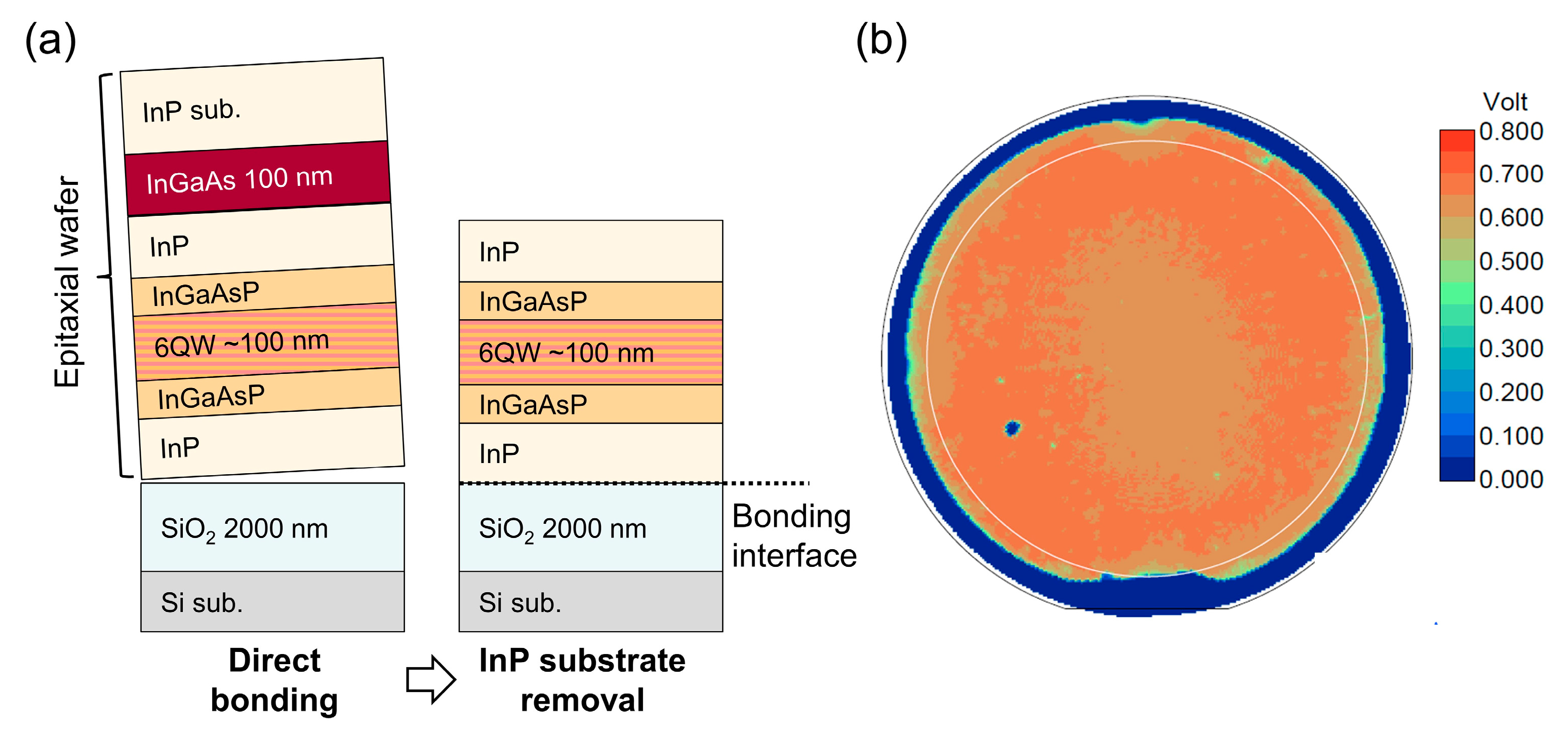

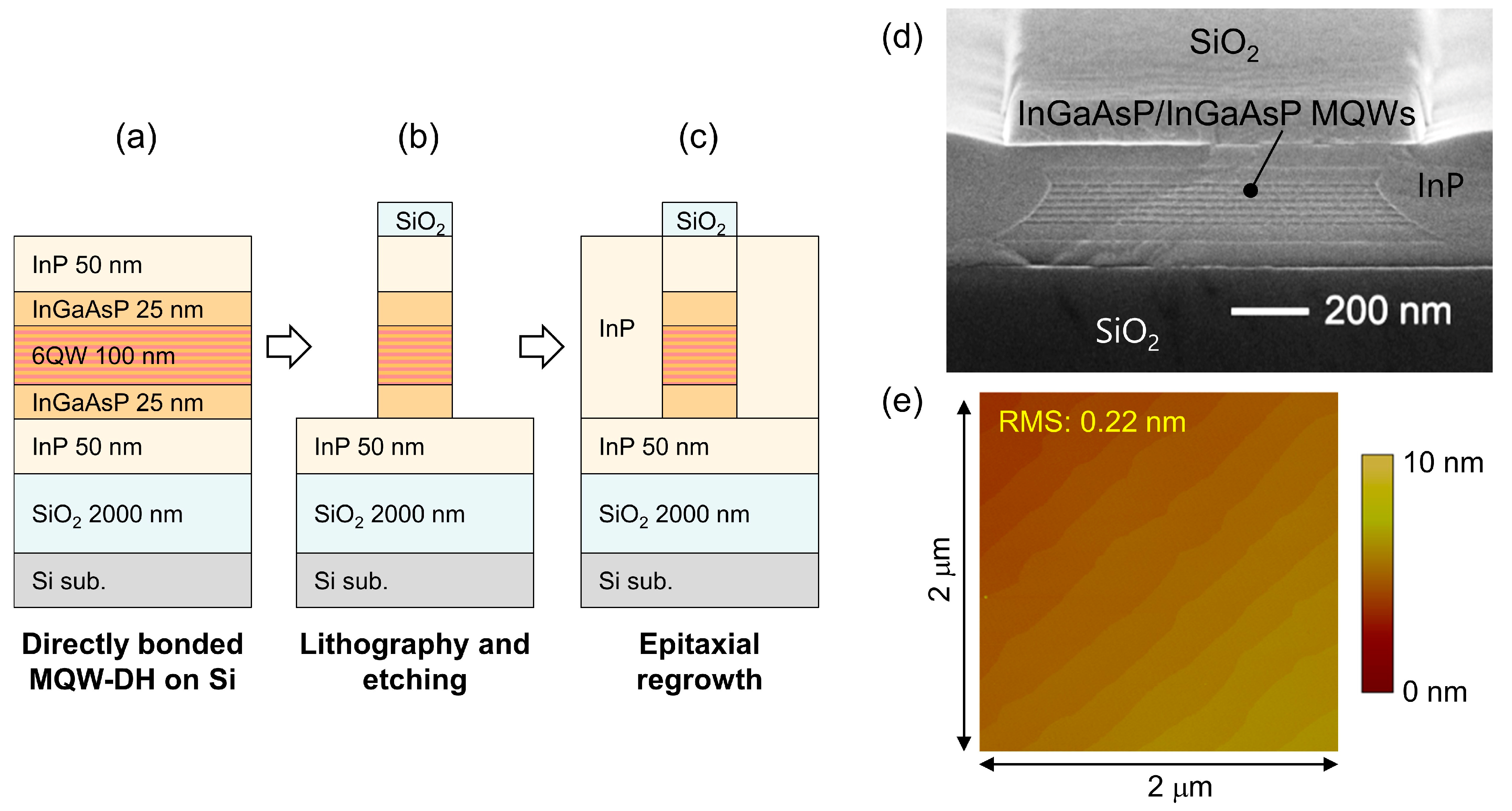



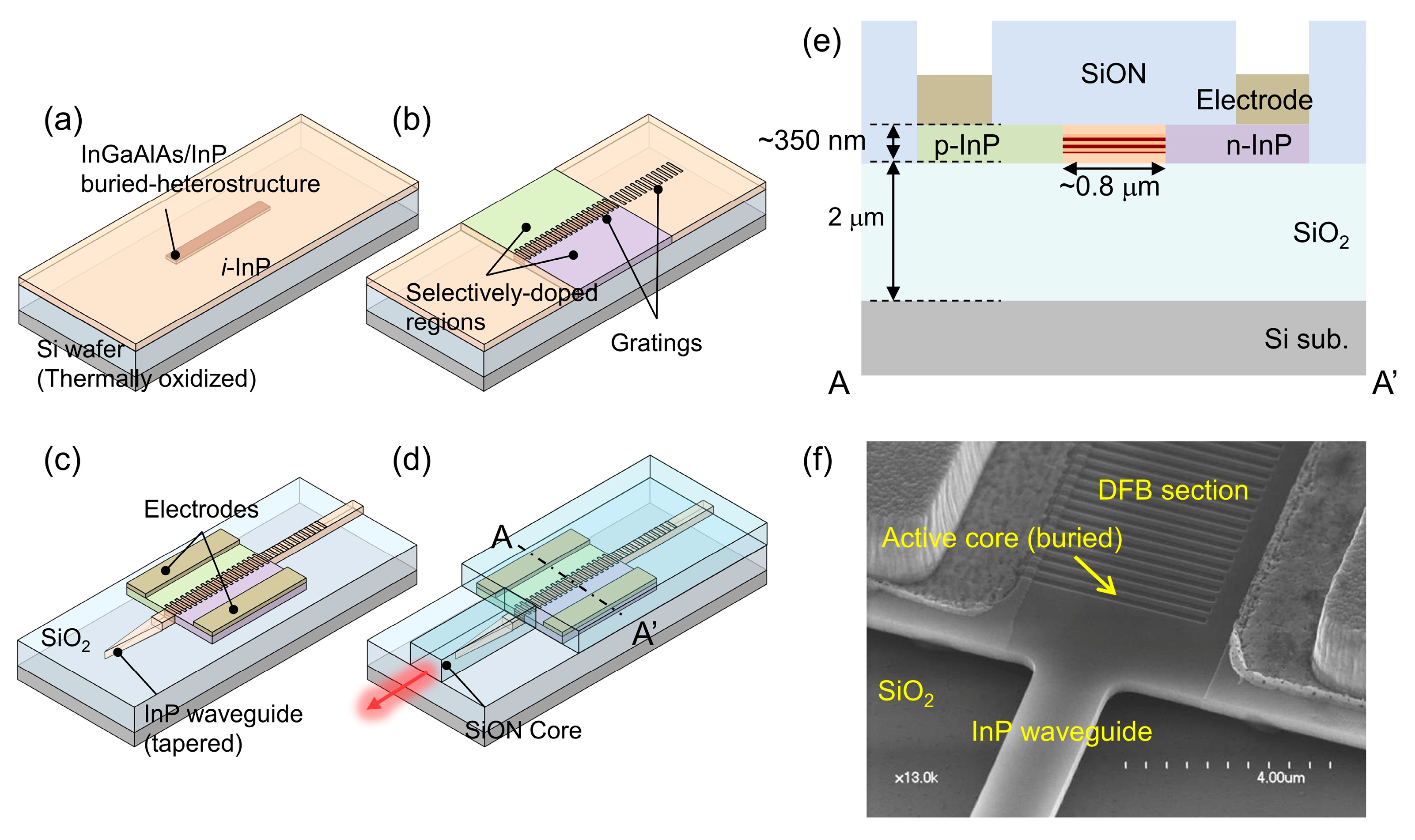

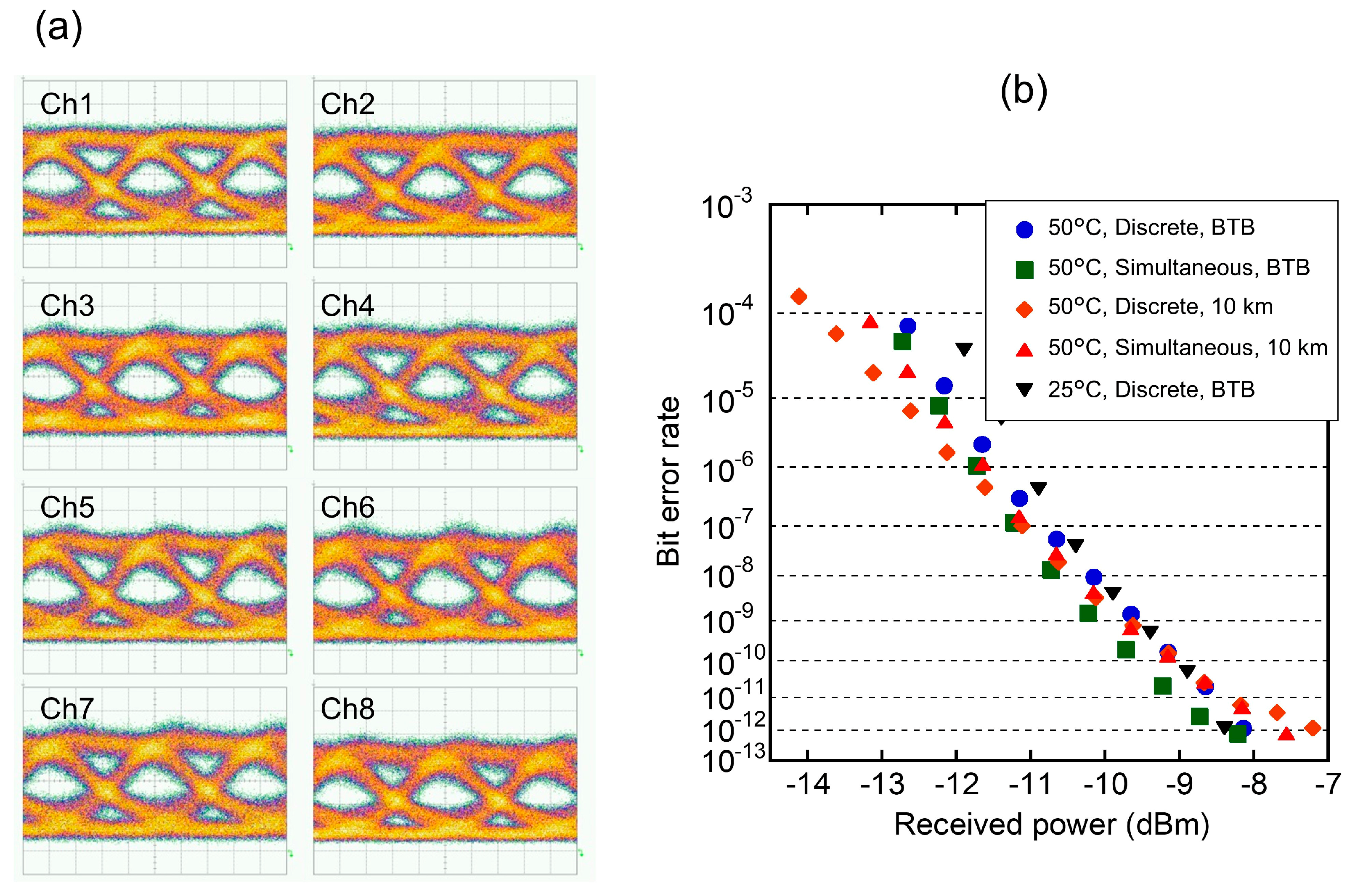

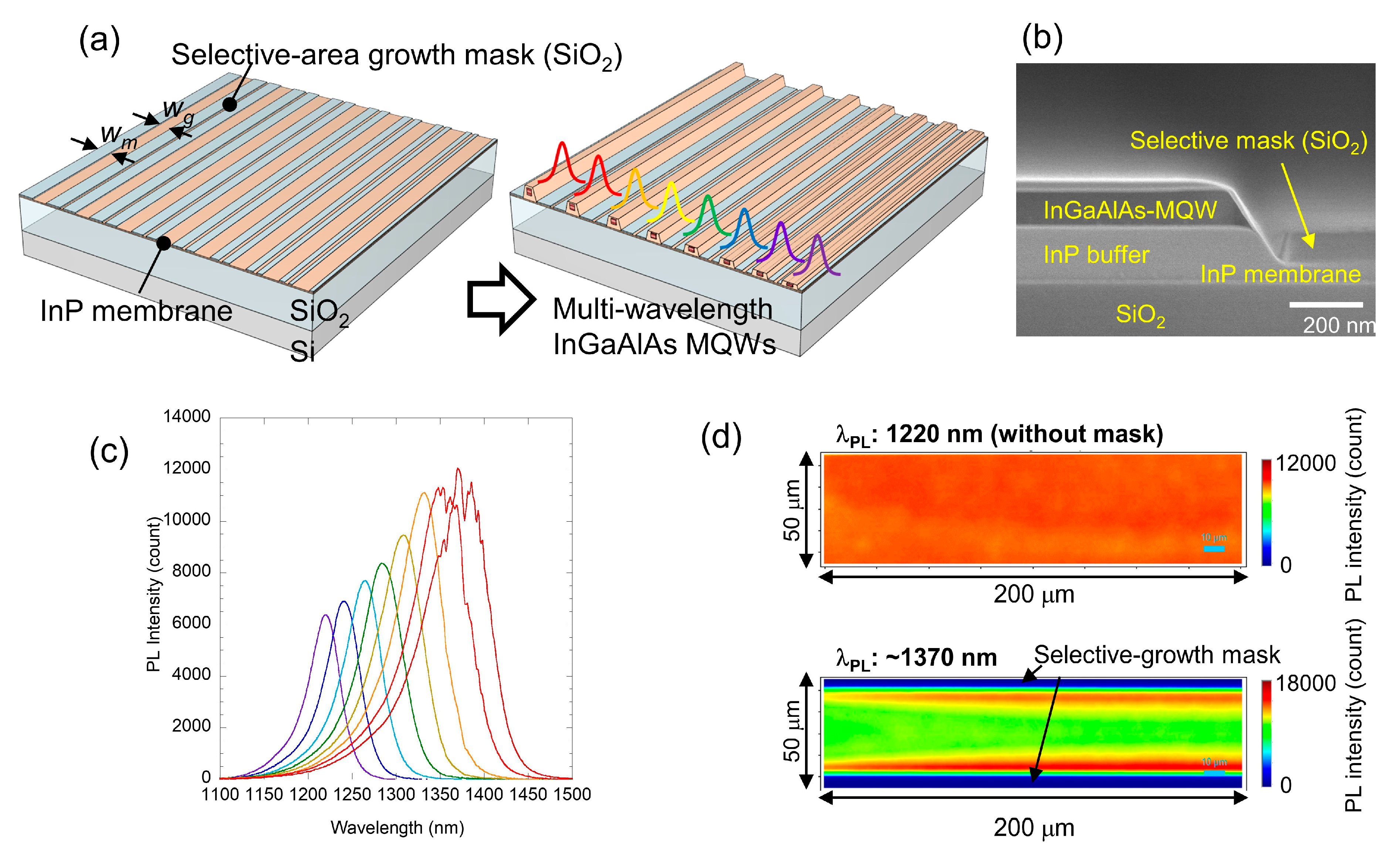

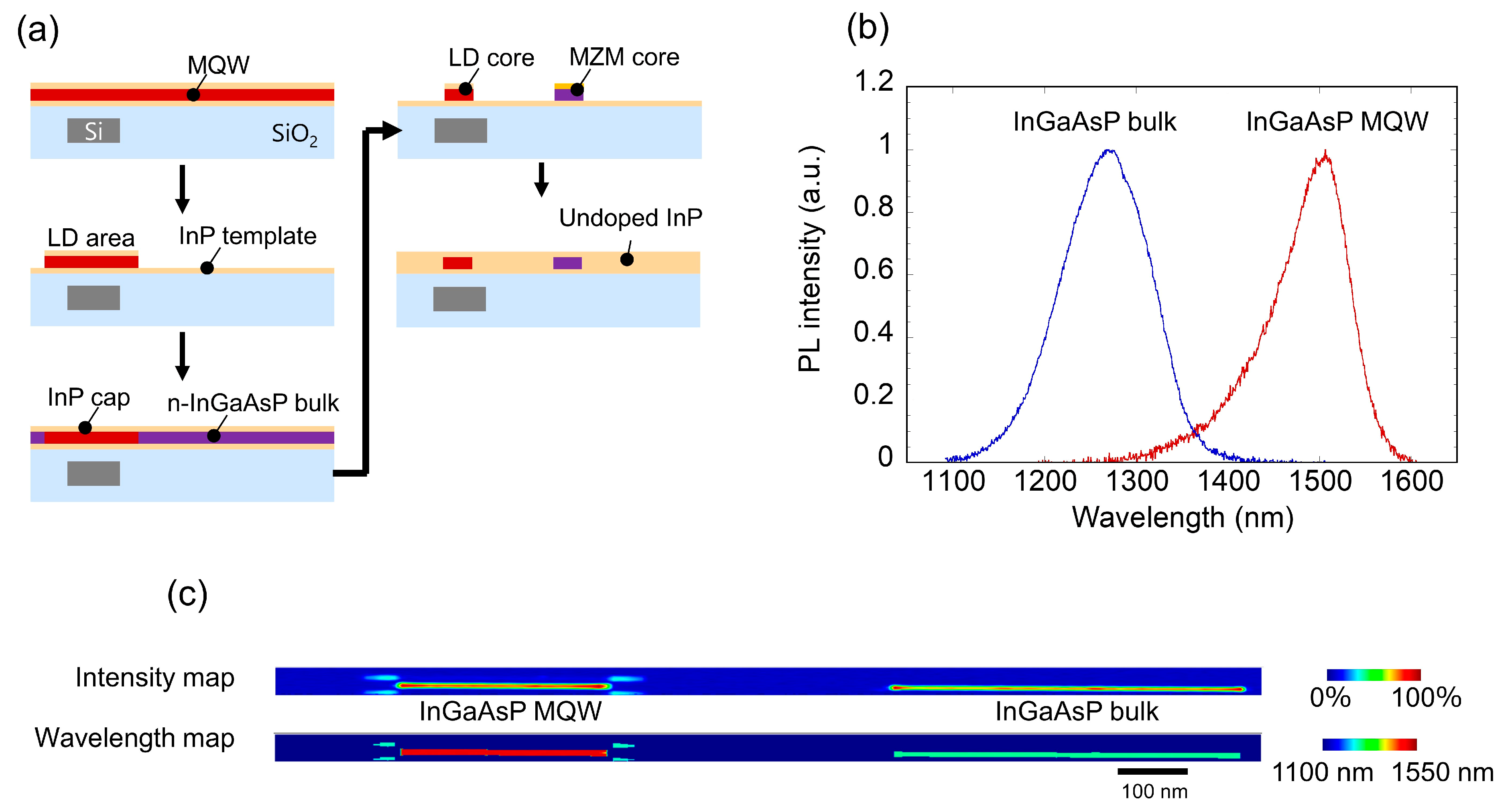
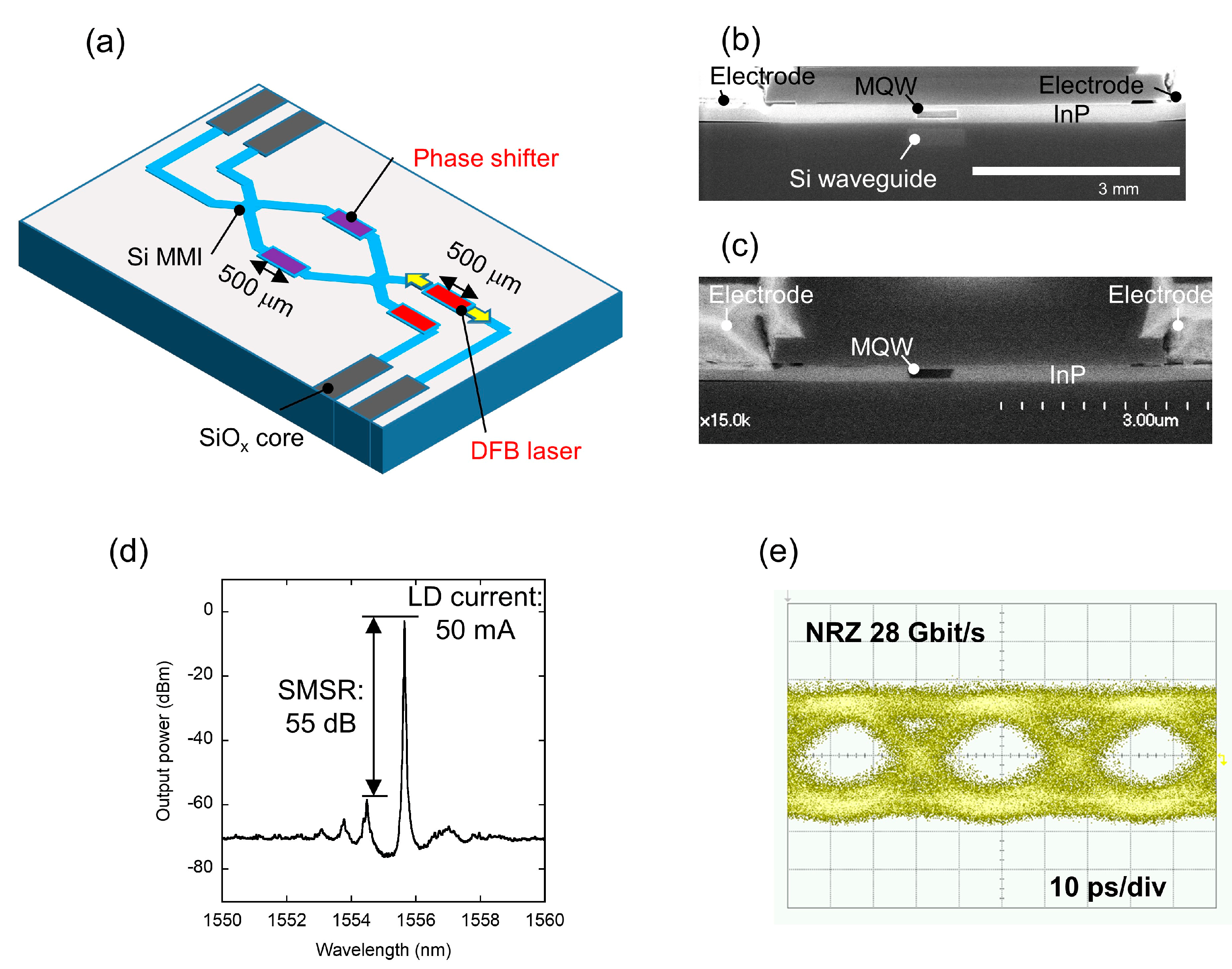
Publisher’s Note: MDPI stays neutral with regard to jurisdictional claims in published maps and institutional affiliations. |
© 2021 by the authors. Licensee MDPI, Basel, Switzerland. This article is an open access article distributed under the terms and conditions of the Creative Commons Attribution (CC BY) license (http://creativecommons.org/licenses/by/4.0/).
Share and Cite
Fujii, T.; Hiraki, T.; Aihara, T.; Nishi, H.; Takeda, K.; Sato, T.; Kakitsuka, T.; Tsuchizawa, T.; Matsuo, S. Development of an Epitaxial Growth Technique Using III-V on a Si Platform for Heterogeneous Integration of Membrane Photonic Devices on Si. Appl. Sci. 2021, 11, 1801. https://doi.org/10.3390/app11041801
Fujii T, Hiraki T, Aihara T, Nishi H, Takeda K, Sato T, Kakitsuka T, Tsuchizawa T, Matsuo S. Development of an Epitaxial Growth Technique Using III-V on a Si Platform for Heterogeneous Integration of Membrane Photonic Devices on Si. Applied Sciences. 2021; 11(4):1801. https://doi.org/10.3390/app11041801
Chicago/Turabian StyleFujii, Takuro, Tatsurou Hiraki, Takuma Aihara, Hidetaka Nishi, Koji Takeda, Tomonari Sato, Takaaki Kakitsuka, Tai Tsuchizawa, and Shinji Matsuo. 2021. "Development of an Epitaxial Growth Technique Using III-V on a Si Platform for Heterogeneous Integration of Membrane Photonic Devices on Si" Applied Sciences 11, no. 4: 1801. https://doi.org/10.3390/app11041801





